Background:
I create this site for the wonder of this holiday season. I grew up in
a German household in Minnesota in the late 50s. My mother brought
her German Christmas traditions with her that included of course
Christmas trees with decorations, songs sung by the piano. My favorite
was a care package from my Grandmother from near Stuttgart, Germany.
It always contained special home made cookies, stuffed penguins and
other treasures. I also do this for the curiousity of history and
origins of traditions. Please enjoy and email any
comments, suggestions and additions. Thank you, Steve Garson
Quick Links
• Acient Origins - Pre-Christ
• Saint Nicholas - Precursor of Santa Claus and gift giving
• The Pagan and Christian Myths and Beliefs
• Spread to northern Europe and Combining of Pagan, Christian St. Nicholas and Christ Child
• Introduction to America and subsequent changes
• Thomas Nast molds the modern Santa Claus
• Santa's Workshop, North Pole and Naughty or Nice list
• Coca-Cola finishes the job
• Present Day North Pole, Santa's Workshop : )
CLICK FOR MAIN XMAS PAGE
The old man with the sack
'Father Christmas' (or 'Santa Claus') has become the human face of Christmas. Pictures will be seen everywhere of the old man with long white beard, red coat, and bag of toys. Children are taught that he brings them presents the night before Christmas (or in some countries on December 6th - St. Nicholas' Day), and many children up to the age of 7 or 8 really believe this is true. In most countries, it is said that he lives near the North Pole, and arrives through the sky on a sledge (snow-cart) pulled by reindeer. He comes into houses down the chimney at midnight and places presents for the children in socks or bags by their beds or in front of the family Christmas tree.
In shops or at children's parties, someone will dress up as Father Christmas and give small presents to children, or ask them what gifts they want for Christmas. Christmas can be a time of magic and excitement for children.
Who was he?
Father Christmas is based on a real person, St. Nicholas, which explains his other name 'Santa Claus' which comes from the Dutch 'Sinterklaas'. Nicholas was a Christian leader from Myra (in modern-day Turkey) in the 4th century AD. He was very shy, and wanted to give money to poor people without them knowing about it. It is said that one day, he climbed the roof of a house and dropped a purse of money down the chimney. It landed in the stocking which a girl had put to dry by the fire! This may explain the belief that Father Christmas comes down the chimney and places gifts in children's stockings.
BACK TO TOP
The many names of Santa Claus:
Original name: Saint Nicholas • Saint Nick • Nicholas of Myra
Armenia - Gaghant Baba
Bulgaria - Diado Coleda
China - Shengdan Laoren
Czechoslovakia - Svaty Miklas
Dutch - Sinterklaas or Sinter Claus
England - Father Christmas
Finland - Old Man Christmas
France - Peré Noel
Germany - Christkindl, the Christ Child • Kriss Kringle • Der Weinachtsmann • Sanct Herr Nicholaas • Sankt Nikolaus
Greece - Hagios Nikolaos, Bishop of Myra
Holland - Sanct Herr Nicholaas or Sinter Klaas
Hungary - Mikulas
India - Ganesha
Indonesia - Sinterklas
Italy - Babbo Natale or Befana
Japan - Santa Kurohsu
Mexico/Spain - Three Kings
North America - Santa Claus • Santa
Poland - Gwiazdor
Russia - Basbouschka
Scandinavia - Julenisse
Slovenia - Bozicek
Yugoslavia - Deda Mraz
CHRONOLOGY
Ancient Origins - Pre-Christ.......... BACK TO TOP
The middle of winter has long been a time of celebration around the world. Centuries before the arrival of the man called Jesus, early Europeans celebrated light and birth in the darkest days of winter. Many peoples rejoiced during the winter solstice, when the worst of the winter was behind them and they could look forward to longer days and extended hours of sunlight.
In Scandinavia, the Norse celebrated Yule from December 21, the winter solstice, through January. In recognition of the return of the sun, fathers and sons would bring home large logs, which they would set on fire. The people would feast until the log burned out, which could take as many as 12 days. The Norse believed that each spark from the fire represented a new pig or calf that would be born during the coming year.
The
end of December was a perfect time for celebration in most areas of
Europe. At that time of year, most cattle were slaughtered so they
would not have to be fed during the winter. For many, it was the only
time of year when they had a supply of fresh meat. In addition, most
wine and beer made during the year was finally fermented and ready
for drinking.
In Germany, people honored the pagan god Oden during the mid-winter holiday.
Germans were terrified of Oden, as they believed he made nocturnal flights
through the sky to observe his people, and then decide who would prosper
or perish. Because of his presence, many people chose to stay inside.
Where did religion come in?
In newly Christianized areas where the pagan Celtic and Germanic cults
remained strong, legends of the god Wodan were blended with those of
various Christian saints; Saint Nicholas was one of these. There were
Christian areas where Saint Nicholas ruled alone; in other locations,
he was assisted by the pagan Dark Helper (the slave he had inherited
from the Germanic god Wodan). In other remote areas, where the Church
held little power, ancient pockets of the Olde Religion controlled traditions.
Here the Dark Helper ruled alone, sometimes in a most confusing manner,
using the cover name of Saint Nicholas or "Klaus," without
in any way changing his threatening, Herne/Pan, fur-clad appearance.
(This was the figure later used by the artist Nast as the model for the
early American Santa Claus.)
The reason for choosing the day of December 25th as Christ's birthday
is usually held that the day was chosen to correspond to pagan festivals
that took place around the time of the winter solstice, when the days
begin to lengthen, to celebrate the "rebirth of the sun". Northern
European tribes celebrated their chief festival of Yule at the winter
solstice to commemorate the rebirth of the sun as the giver of light,
warmth, and life. The Roman Saturnalia (a festival dedicated to Saturn,
the god of agriculture, and to the renewed power of the sun), also took
place at this time, and some Christmas customs are rooted in this ancient
pagan celebration. The early church did not celebrate the anniversary
of the birth of Christ. The Gospels indicate neither the month nor the
day on which Christ was born. Although Luke places the birth in a historical
perspective, even the year cannot be determined with exactitude. If the
date of Christ's birth were of real religious significance, then the
day and the month would have been given; as was given in the first passover.
Some of the early church fathers, including Origin, stated for the record
that it was blasphemous to celebrate this festival.
Most Christian churches except the Armenian Church observe the birth
of Christ on December 25. This date was not set in the West until about
the middle of the fourth century, and in the East until about a century
later. The Armenians follow the old Eastern custom of honoring Christ's
birth on January 6, the day of the Epiphany, commemorating in the West
chiefly the visit of the Magi to the infant Jesus, and in the East, Christ's
Baptism. Some churches hold their most elaborate festivals on January
6, and in parts of the United States this date has been celebrated as "Old
Christmas" or "Little Christmas". This time, over a century
after the beginning of the Roman Catholic Church would account for much.
The Catholic practice of assimilating the rituals, images, festivals
and even gods of pagan religions, into their brand of Christianity by
giving these all "Christian" names or purposes, would explain
these dates and their significance.
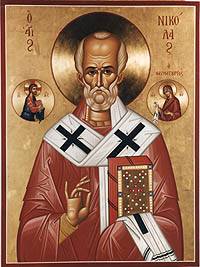 |
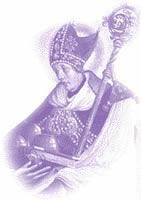 Saint Nicholas |
|
4thCent.
AD - Saint Nicholas.......... BACK
TO TOP
The
basis for the Christian-era Santa Claus can be traced back hundreds of
years to a monk named St.
Nicholas, the
Patron Saint of Giving. Within
both Western and Eastern Christian Churches similar mythology, or tradition,
exists.
His Life
It is believed that Nicholas was born sometime around 280 A.D. in Patara,
near Myra (of Smyrna (Izmir)) in modern-day Turkey. Born an only child
of a wealthy family, he was orphaned at an early age when both parents
died of the plague.
He grew up in a monastery and at the age of 17 became one of the youngest
priests ever. He traveled to Palestine and Egypt when he was young. While
still a young boy he was made Bishop of Myra, and because of this he
has been known ever since as the Boy Bishop. The bishop's hat or miter,
long flowing gown, white beard and red cape was the forerunner of his
appearance.
He was later imprisoned during persecutions of the Emperor Diocletian,
but was fortunately released by the more humanitarian Emperor Constantine.
He attended the first council of Nicaea in 325.
After his death, December 6, A.D. 342, he was elevated to sainthood.
At about the same time Nicholas lived, Pope Julius I decided to establish
a date for the celebration of the birth of Jesus. As the actual time
of year for this event was unknown, the Pope decided to assign the holiday
to December 25th. There had long been a pagan midwinter festival at this
time of year and the Pope hoped to use the holiday to christianize the
celebrations. Eventually the Catholic Church started celebrating Christmas,
December 24/25th, and St. Nicholas, Dec. 6, was incorporated into the
season. He has been the patron saint of Russia, Moscow, Greece, children,
sailors, prisoners, bakers, pawnbrokers, shopkeepers and wolves.
Note: The Catholic Saint Nicholas also had a confusing past. He was a
compilation of two separate saints (one from Myra in Asia Minor, the
other from Pinora), both of whom were – as the Church now admits – nothing
more than Christianized water deities (possibly related to the Greco-Roman
god Poseidon/Neptune.)
Gift Giving - Precursor to the giving of
presents on Christmas
Many stories are told of his generosity as he gave his wealth away in
the form of gifts to those in need, especially children. Legends tell
of him either dropping bags of gold down chimneys or throwing the bags
through the windows where they landed in the stockings hung from the
fireplace to dry. It is said that he gave away all of his inherited wealth
and traveled the countryside helping the poor and sick. One of the best
known of the St. Nicholas stories is that he saved three poor sisters
from being sold into slavery or prostitution by their father by providing
them with a dowry so that they could be married.
His gift-giving role in Christmas rites probably follows from his fame
as the friend of children. The story also tells that he used to give
anonymous donations of gold coins to persons in need. His cult spread
in Europe and Christmas presents were distributed on December 6th when
the celebration of St. Nicholas took place.
In
many countries this day is still the day of Christmas gift-giving,
although there is a mounting pressure everywhere to conform to the
custom of 24th/25th December. The relics of St. Nicholas are in the
basilica of St. Nicola, in Bari, Italy (they were stolen from Myra
in 1087 AD). For this reason he is sometimes known as St. Nicholas
of Bari.
After
the death of St. Nicholas and spread of his legend........... BACK
TO TOP
Combining of Ancient Beliefs and Christian St. Nicholas.
The Orthodox Church later raised St. Nicholas, miracle worker, to a position
of great esteem. It was in his honor that Russia's oldest church, for
example, was built. For its part, the Roman Catholic Church honored Nicholas
as one who helped children and the poor. St. Nicholas became the patron
saint of children and seafarers. His name day is December 6th, the anniversary
of his death (died on December 6, A.D. 342). This was traditionally considered
a lucky day to make large purchases or to get married.
The historical Saint Nicholas was venerated in early Christian legend
for saving storm-tossed sailors, defending young children, and giving
generous gifts to the poor. Although many of the stories about Saint
Nicholas are of doubtful authenticity (for example, he is said to have
delivered a bag of gold to a poor family by tossing it through a window),
his legend spread throughout Europe, emphasizing his role as a traditional
bringer of gifts. By the Renaissance, St. Nicholas was the most popular
saint in Europe.
The Christian figure of Saint Nicholas replaced or incorporated various
pagan gift-giving figures such as the Roman Befana and the Germanic Berchta
and Knecht Ruprecht. The saint was called Sankt Nikolaus in Germany and
Sanct Herr Nicholaas or Sinter Klaas in Holland.
In Holland and several other European countries, the Saint Nicholas figure
is still highly esteemed. He appears as a tall dignified bearded white-haired
old man dressed as a Catholic bishop complete with cloak, mytre, and
pastoral staff, a seemingly genuine Catholic saint, but with a bizarre
quite unsaintly habit of riding through the skies on a white horse followed
by his Dark Helper, Black Peter, an elf whose job was to whip the naughty
children. It seems that our Catholic saint inherited some of these customs
from the pagan Germanic god Wodan, who had also been a bearded, white-haired
old man, also dressed in a hat and cloak, carried a staff (or spear),
rode a holy white horse and dragged along the same dark slave/helper
on a chain.
The feast day of Nicholas, when presents were received, was traditionally
observed on December 6.
The Dutch Sinterklaas brings gifts to good children, while bad children
are harassed by Zwarte Piet, the Dark Helper, who – brandishing
his peculiar broom-like rod – threatens to put sassy young women
and naughty children in the sack in which he has carried the gifts, the
idea being that he will take them away to some terrible place in Spain
(where Saint Nicholas, for no known historical reason, was supposed to
have come from). This, of course, never happens since the good Christian
Sinterklaas always intervenes on behalf of the naughty child – provided
the child promises to better his or her ways. The bad (pagan) Dark Helper
is then admonished by Sinterklaas and ordered to stop threatening the
children.
Next, Sinterklaas distributes gifts to all "who have been good" (or
until the twentieth century, to all "who knew their prayers").
In exchange, the children are supposed to leave food offerings for the
saint's horse (usually hay and carrots), placed in either a shoe or stocking.
In some areas, a glass of gin is also left as an offering for the good
saint himself. When, by daybreak, the offerings have disappeared and
been replaced by gifts, it proves that Sinterklaas has indeed paid a
visit during the night.
We
can clearly recognize in all this the lesson taught the pagans by the
Christian Church, here represented by Saint Nicholas: You may enjoy
your old fall/winter feasts, as long as you have learned your prayers
and become good Christians. You will then be rewarded, but if you have
not done so, you will be dragged away to hell by your own fearful,
pagan past and its representative, the dark Herne/Pan – who is
none other than Satan himself – unless you repent, here and now!
Dark
Ages .......... BACK
TO TOP
After the Vikings raided the Mediterranean, they brought the Christian
Saint Nicholas cult from Italy to northern Europe, and there proceeded
to build Saint Nicholas churches for the protection of their sailors.
When, for instance, William the Conqueror's fleet was hit by a storm
during his invasion of England, he is known to have called out for protection
to Saint Nicholas. Although in those days, church services only mentioned
Saint Nicholas as the protector of seafarers, they initially condoned
a blending of the Mediterranean Nicholas myths with some that had been
attached to the pagan Germanic god Wodan and to those of the even earlier
Herne/Pan traditions.
By absorbing such pagan feasts and traditions, the Christian Church could
subtly bring in its own theology: in this case, establishing the good
Saint Nicholas, bringer of love and gifts, while grudgingly allowing
the presence of the Olde Religion's Herne/Pan, but only as a slave to
Saint Nicholas. Thus, in parts of Europe, the Church turned Herne into
Saint Nicholas' captive, chained Dark Helper; none other than Satan,
the Dark One, symbolic of all evil. His only remaining tasks now were
to carry the bag, scare maidens and children into devout behavior, and
drag sinners and pagans off to the Christian hell. Yet, in spite of this
character assassination, the poor masses continued to see in this enslaved
Dark Helper a reflection of their own enslavement. He remained their
Herne, thumbing his nose at the Christian Church; a mischievous, nostalgic
reminder of the days of their own free and lusty pagan past.
Middle Ages .......... BACK
TO TOP
His fame spread rapidly during the Middle Ages and thousands of churches
are dedicated to him.
When the Reformation took place, veneration of saints was discouraged.
German Protestants encouraged veneration of the (Christ child) as a gift
giver on his own feast day, December 25. The Nicholas tradition prevailed,
it became attached to Christmas itself.
The new Protestants no longer desired St. Nicholas as their gift-giver
as he was too closely tied to the Catholic Church. Therefore, each country
or region developed their own gift-giver. In France he was known as Pere
Noel. In England he was Father Christmas (always depicted with sprigs
of holly, ivy or mistletoe).
In the Protestant areas of central and northern Germany, St. Nicholas
later became known as der Weinachtsmann (Christmas man). Julenisse in
Scandinavia. To the Dutch, he was Sinterklaas. The term Christkindl evolved
to Kriss Kringle, another nickname for Santa Claus. These Santas were
arrayed in every color of the rainbow--sometimes even in black. But they
all had long white beards and carried gifts for the children.
St. Nicholas with a European flair
Nicholas' natural affinity with children led him to be adopted as their
patron saint, and his generosity to the custom ofgiving gifts to them
on his feast day. The custom became especially widespread in the Low
Countries, where the Dutch seamen had carried reports home of the saint's
generosity. St. Nicholas was, however, a tremendously popular saint everywhere.
Both Russia and Greece adopted him as their patron saint, and there are
more churches in the world named after him than any of the apostles (especially
The Netherlands).
In the European countries, St. Nicholas is usually pictured as a bearded saint, wearing ecclesiastical robes and riding a white horse. He carries a basket of gifts for the good children and a batch of rods for the naughty ones.
In old Czechoslovakia, Svaty Mikulas was brought down from heaven on a golden cord by an angel. When he arrived on Christmas Day, the children rushed to the table to say their prayers. If they did well, he told the angel who came with him to give them presents.
In parts of the Alps, "ghosts of the field" cleared the way for St. Nicholas. Behind them came a man wearing a goat's head, and a masked demon with a birch switch. In Germany, twelve young men dressed in straw and wearing animal masks danced along after St. Nicholas, ringing cowbells. At each house, after gifts were given, the masked men drove the young people out and pretended to beat them!
For the children of the Netherlands, December 6th is still more exciting than Christmas Day, for then St. Nicholas arrives. His arrival is celebrated and this is the day when children receive their presents. The excitement begins on the last Sunday in November, where everywhere can be heard the words, "Look there is the steamer bringing us St. Nick!"
St. Nicholas traditionally arrives by sea and disembarks at Amsterdam. He then mounts a white horse for a processional ride through the streets. Clothed in a bishop's scarlet cope and mitre, he wears white gloves and an enormous bishop's ring on his left hand. Black Peter accompanies Nicholas. St. Nicholas' arrival is greeted with cheers from the thousands of children and adults who line the route. Supposedly the bishop came from Spain. This story can be traced back to the sixteenth century when the Spanish dominated the Low Countries. The doublet, puffed velvet breeches, hose and plumed berets worn by his attendants – in particular Black Peter – are another forcible reminder of that period. Black Peter carries a large sack in which he is said to put all the boys and girls who have misbehaved during the course of the last 12 months. With bad kids in his sack, Black Peter then takes them away to Spain.
Immigrants
to the New World must have recognized something familiar in the little
figure of St. Nick. His fur costume suggested Pelz-Nicol to a Bavarian,
and the little gnome-like figure Jule-nissen to a Scandinavian. His
elfish qualities rang bells with other nationalities too, for example
the Irish with their tradition of the "little people". In
many ways, Santa was recognizable for many people, which probably helps
to explain why he was adopted so readily – a new, but familiar,
symbol for a new country.
Gift-giving comes of age.......... BACK
TO TOP
As in many other European countries, if presents were exchanged at this
season, it was usually done at New Year's Eve and they were between adults
rather than for children. In the 1840s, however, there was an increasing
emphasis on Christmas Day. This seems to have happened for several reasons.
The press – which now reached a far wider audience – stressed
the fact that Christmas Day was the celebration of the birth of Jesus.
Birthdays had always been a day for giving presents and it was a natural
step to celebrate Jesus' birth by giving gifts on that day.
Before Christmas had been banned by Oliver Cromwell from 1644 to 1660, there had been an old custom of giving sweets and small presents to children on Christmas Day. This had virtually stopped, but now the custom was enjoying a revival, in part because of the many articles that were being written in the Christmas editions of magazines about the "old traditions" of Christmas. Another influential element was that, just as in America, children were becoming a greater focus in society, and it seemed appropriate to use this time to give them greater emphasis.
The importation of the Christmas tree from Germany, and the accompanying rituals of gift giving on Christmas Eve, gave further impetus to the idea of presents. Santa Claus provided the final influence. By the end of the century, Christmas Day was firmly fixed – in England at least – as a children's festival and the day on which presents were given.
Santa Claus, or "Father Christmas", came back into English Christmas festivities when people were reminded of him from America. This injected new life into the English Christmas and was the answer to those who prayed that Father Christmas and his customs may be restored "to some portion of their ancient honors."
Celebrations around the midwinter solstice had been used for gift giving since Roman times. At the Roman winter festival – called the Saturnalia because they worshipped Saturn as the god of everything that grew – the Romans had a public holiday that lasted for a week. Everyone took part in the feasting and games. Even the slaves were made free for a day and allowed to say and do what they liked. People exchanged presents; a custom called Strenae, as a symbol of goodwill. At first, these gifts were green boughs from the grove of the goddess Strenia. Later, gifts were given of sweet pastries to ensure a pleasant year, precious stones, gold or silver coins to symbolize wealth, and, the most popular of all, candles as a symbol of warmth and light. As the Roman Empire spread, so did this custom of gift giving to other parts of the world. Since the Saturnalia marked the beginning of a new year, in most countries presents were given on New Year's Day, not Christmas Day. The advent and spread of Christianity caused the gift giving to be moved to other times of the year.
In Germany, the packages of Christmas gifts were called "Christ-bundles" and often came in bundles of three. There was something rewarding, something useful and something for discipline. In the seventeenth century, a typical bundle would contain candy, sugarplums, cakes, apples, nuts, dolls and toys. The useful things would be clothes, caps, mittens, stockings, shoes and slippers. The gifts "that belong to teaching, obedience and discipline" were items such as ABC tables, paper, pencils, books and the "Christ-rod". This rod, attached to the bundle, was a pointed reminder for good behavior. Another way of presenting gifts was the old German custom of the "Christmas ship", in which bundles for children were stored away. To some extent, this custom was also adopted in England, but never with the same degree of popularity.
In the centuries before Santa Claus was well known, and still today in many countries where he has not been widely adopted, the child Jesus is the gift-bringer. He comes with the angels during the night, trimming the tree and putting the presents underneath.
In Spain and Spanish-speaking countries, the child Jesus (el Nino Jesus) brings Christmas gifts for the children during Holy Night. He is found in the morning in the previously empty crib, and all the presents are arranged in front of it.
The
German name of the Christ Child is Christkind, commonly used in its
diminutive form Christkindel. His messenger, a young girl with a golden
crown who holds a tiny "Tree of Light", brings the gifts
of the Christ Child. Still today in America, "Kriss Kringle" --
deriving from the German Christkindel -- is another name used for Santa
Claus.
Santa may appear under different names and in different guises. For example,
French children leave their shoes by the fireplace on Christmas Eve so
that they can be filled with gifts by Peré Noel. In the morning
they find that the shoes have been filled and that sweets, fruit, nuts
and small toys have also been hung on the branches of the tree.
In Sweden, the children wait eagerly for Jultomten, whose sleigh is drawn by the Julbocker, the goats of the thunder god Thor. With his red suit and cap, and a bulging sack on his back, he looks much like Santa Claus as we know him. In Denmark, too, the gift-bringer Julemanden carries a sack and is brought by reindeer. Elves known as Juul Nisse come from the attic, where they live, to help with the chores during Yuletide. The children put a saucer of milk or rice pudding for them in the attic and are delighted to find it empty in the morning.
The children of Poland receive their gifts from the stars, while in Hungary the angels bring them. Children of Syria receive theirs from the Youngest Camel on January 6th, which is Three Kings' Day. The children of Spain, Mexico, Puerto Rico, the Philippines and South American countries also receive gifts at this time as well as on Holy Night, but from the Three Kings.
In Italy, an unusual figure is the gift bringer for children. It is the "Lady Befana" or "Bufana" (La Befana}, the ageless wanderer. Apparently La Befana refused to go to Bethlehem with the wise men when they passed her door, and she has been searching for the Christ Child ever since. On the Eve of Three Kings' Day (Epiphany), she wanders from house to house, peering into the faces of the children and leaving gifts. On that day, the children roam the streets, blowing their paper trumpets and receiving the gifts which La Befana has given them. Her name comes from the word "Epiphany".
In
Russia, Kolyada is the name for Christmas. The word is derived from
the old Roman Kalends, the celebration of the New Year at the first
of January. Kolyada is also the name of the white-robed woman who rides
a sled drawn by a single white horse from house to house on Christmas
Eve to bring gifts to the children. Kolya (Nicholas), who leaves wheat
cakes on the windowsills, joins her. The gift bringer in Russia is
also a legendary woman, called Babushka (Grandmother). She is said
to have misdirected the Magi when they inquired their way to Bethlehem.
According to another version, she refused hospitality to the Holy Family
on its way to Egypt. Whatever her fault, she repented of her unkindness
and, to make reparation for her sin, she now goes about the world on
Christmas Eve looking for the Christ Child and distributing gifts to
the children.
1600's.......... BACK
TO TOP
The Dutch, Sinterklaas was was mispronounced in America and became Santa
Claus.
Santa comes to New York
In Europe, after the Reformation of the seventeenth century, the feast
and veneration of Saint Nicholas was abolished in many places, including
England, where a figure known as Father Christmas was substituted. Father
Christmas is a winter deity, white-haired and bearded, who wears a crown
of holly. The German settlers brought their beliefs and stories about
Saint Nicholas with them to this country during the two great waves of
immigration, in the early 1700s and the middle 1800s, and Hollanders
brought their Sinter Klaas to their settlement of New Amsterdam. As the
English colonized New York, they adopted their Father Christmas, who
did not bring gifts, to these traditions, and Santa Claus as we know
him today was born.
1642.......... BACK
TO TOP
Christmas even in more modern times has not always been remembered with
gaiety and good cheer. Excessive frivolity has always been frowned upon
by some, and Christmas was not celebrated by the Puritans or Calvinists.
When the Puritans came to power in England under Oliver Cromwell in 1642,
Christmas celebrations were banned as evidences of anti religious sentiment.
Penalties were exacted for celebrating Christmas, and for staying home
from work on Christmas day. The Puritan tradition was brought to New
England, where Christmas did not become a legal holiday until 1856.
1773
As early as 1773 the name appeared in the American press as "St.
A Claus," but it was the popular author Washington Irving who gave
Americans their first detailed information about the Dutch version of
Saint Nicholas. Washington Irving first described Santa's sleigh flying.
The sleigh was said to be pulled by reindeer – giving St. Nick
an exotic link with the far north – a land of cold and snow where
few, if any, people traveled and was hence mysterious and remote.
1804
In 1804, the New York Historical Society was founded with Nicholas as
its patron saint, its members reviving the Dutch tradition of St. Nicholas
as a gift-bringer.
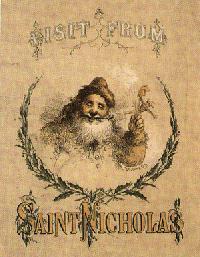 |
Santa Claus the gift-bringer. |
|
1809.......... BACK
TO TOP
In 1809, Washington Irving published his satirical A History of New York,
by one "Diedrich Knickerbocker," a work that poked fun at New
York's Dutch past (St. Nicholas included).
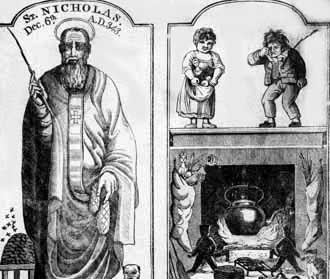 |
Saint Nicholas or "Sancte Claus," in a woodcut by Alexander Anderson done for the New York Historical Society. |
|
1810
When Irving became a member of the New York Historical Society the following
year, the annual St. Nicholas Day dinner festivities included a woodcut
of the traditional Nicholas figure (tall, with long robes) accompanied
by a Dutch rhyme about "Sancte Claus" (in Dutch, "Sinterklaas").
1812
Irving revised his History of New York in 1812, adding details about
Nicholas' "riding over the tops of the trees, in that selfsame waggon
wherein he brings his yearly presents to children." Irving described
the arrival of the saint on horseback (unaccompanied by Black Peter)
each Eve of Saint Nicholas. He helped create the Americanized version
of this mythic figure when he described the saint as "laying a finger
beside his nose" and dropping gifts down chimneys. Soon he began
to be more commonly referred to as Santa Claus.
1821.......... BACK
TO TOP
The reindeer, however, were not first told by Irving. In 1821, a New
York printer named William Gilley issued a poem about a "Santeclaus" who
dressed all in fur and drove a sleigh pulled by one reindeer. Gilley's "Sante," however,
was very short. In his publication called The Children's Friend, he described "Old
Sante Claus with much delight, His reindeer drives this frosty night".
1822
This Dutch-American Saint Nick achieved his fully Americanized form in
the poem "A Visit From Saint Nicholas" more commonly known
as "The Night Before Christmas" published on December 23, 1823
by writer Clement Clarke Moore. He described St. Nicholas as "chubby
and plump, a right jolly old elf". Moore also included such details
as the names of the reindeer; Santa Claus's laughs, winks, and nods;
and the method by which Saint Nicholas, referred to as an elf, returns
up the chimney. (Moore's phrase "lays his finger aside of his nose" was
drawn directly from Irving's 1809 description.)
Clement C. Moore told of eight reindeer and gave their names. Some scholars
think that this poem was actually written by Henry Livingston, Jr., and
there is compelling evidence to support this point of view. Perhaps Livingston
had written a poem that Moore adapted. Whatever the case, in the now-famous
poem, Santa is described as a "jolly old elf," with a team
of eight reindeer, who comes to children on Christmas Eve Day, rather
than December 6 or New Year's Day. One story recounts that Dr. Clement
Moore was inspired to draw the present day Santa Claus by a short, chubby
Dutch friend of his, who had sat by the fire telling stories of St. Nicholas.
Moore's Nicholas was still a small figure, however — the poem describes
a "miniature sleigh" with a "little old driver."
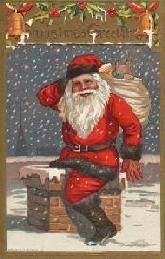 |
Christmas Greeting card with Santa Claus going down the chimney. |
|
1841.......... BACK
TO TOP
Meanwhile, in parts of Europe such as Germany, Nicholas the gift-giver
had been superseded by a representation of the infant Jesus (the Christ
child, or "Christkindlein"). The Christkindlein accompanied
Nicholas-like figures with other names (such as "Père Nöel" in
France), or he travelled with a dwarf-like helper (known in some places
as "Pelznickel," or Nicholas with furs). Belsnickle (as Pelznickel
was known in the German-American dialect of Pennsylvania) was represented
by adults who dressed in furry disguises (including false whiskers),
visited while children were still awake, and put on a scary performance.
Gifts found by children the next morning were credited to Christkindlein,
who had come while everyone was asleep. Over time, the non-visible Christkindlein
(whose name mutated into "Kriss Kringle") was overshadowed
by the visible Belsnickle, and both of them became confused with St.
Nicholas and the emerging figure of Santa Claus.
The modern Santa Claus derived from these two images: St. Nicholas the
elf-like gift bringer described by Moore, and a friendlier "Kriss
Kringle" amalgam of the Christkindlein and Pelznickel figures. The
man-sized version of Santa became the dominant image around 1841, when
a Philadelphia merchant named J.W. Parkinson hired a man to dress in "Criscringle" clothing
and climb the chimney outside his shop.
1856.......... BACK
TO TOP
Christmas becomes a legal holiday.
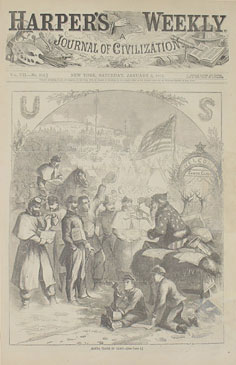 |
"Santa
Claus in Camp," Harper's Weekly, January 3, 1863, cover. Medium 160kb Large 1.0 mb Source: http://cartoons .osu.edu/nast/ 12/06/05 |
|
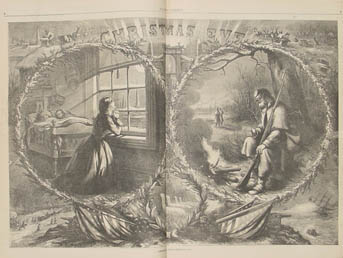 |
"Christmas
Eve 1862" Harper's Weekly, January 3, 1863, p.8-9. Medium 140kb Large 1.1mb |
|
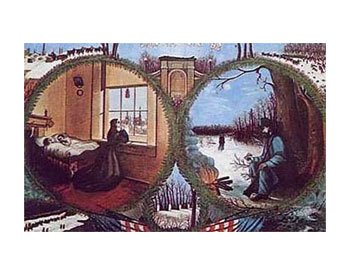 |
1863 .......... BACK
TO TOP
Thomas Nast is another contributor to the American development of Santa
Claus. Although he was born in Bavaria in the 1840s, he came to the United
States when he was six years old. He grew up to become an editorial cartoonist
and illustrator with flair; he is credited with creating and popularizing
the Republican elephant and the Democratic donkey, the symbols of the
two major political parties.
He is also considered the primary source for the way we picture Santa
Claus because of a series of drawings he did for Harper's Weekly between
1863 and 1886. Not having the vaguest idea what Santa Clause was supposed
to look like, the Bavarian-born Nast drew Santa Claus as the winter holiday
figure he remembered from the mountain villages in his Bavarian Alps;
a rather scary, less-than-friendly gnome, dressed in animal skins and
carrying a short broom-like rod with which to threaten girls and boys.
Over the years, Nast's Santa became a bit friendlier and plumper.
Thomas Nast, political cartoonist, created a different illustration each
year of Santa for the cover of Harper's Weekly. His Santa was a plump,
jolly old fellow with a white beard and smoking a long stemmed pipe.
In 1863, during the Civil War, President Abraham Lincoln asked Nast to
do an illustration showing Santa with the Union troops. Many historians
say this was one of the most demoralizing moments for the Confederate
army....seeing Santa side with the North. In the South, by 1863, the
Union had blockaded their ports and very little was able to get through.
Southern families explained to their children that even "Santa" could
not get through the blockade.
The American image of Santa Claus was further
elaborated by illustrator Thomas Nast, who depicted
a rotund Santa for Christmas issues of Harper's magazine from the 1860s
to the 1880s. Children naturally wanted to know where Santa Claus actually
came from. Where did he live when he wasn't delivering presents? Nast
added such details as Santa's Workshop at the North
Pole and Santa's list of the good and bad children of the
world.
Thomas Nast “invented” the image popularly recognized as
Santa Claus. Nast first drew Santa Claus for the 1862 Christmas season
Harper’s Weekly cover and center-fold illustration to memorialize
the family sacrifices of the Union during the early and, for the north,
darkest days of the Civil War.
Nast’s Santa appeared as a kindly figure representing Christmas,
the holiday celebrating the birth of Christ. His use of Santa Claus was
melancholy, sad for the faltering Union war effort in which Nast so fervently
believed, and sad for the separation of soldiers and families. When Nast
created his image of Santa Claus he was drawing on his native German
tradition of Saint Nicholas, a fourth century bishop known for his kindness
and generosity.
In the German Christian tradition December 6 was (and is) Saint Nicholas
day, a festival day honoring Saint Nicholas and a day of gift giving.
Nast combined this tradition of Saint Nicholas with other German folk
traditions of elves to draw his Santa in 1862.
The claim that Nast “invented” Santa Claus in 1862 is thus
accurate, but the assertion overlooks the centuries-long antecedents
to his invention. Santa Claus thrived thereafter in American culture
both Christian and secular. During the Civil War, Christmas was a traditional
festival celebration in the United States, although not yet a holiday.
In Nast’s time Christmas was not a day when offices or factories
closed; but the development of Christmas as a holiday and the use of
Santa Claus as a secular symbol of gift giving removed from its Christian
antecedents occurred during Nast’s lifetime. The modern American
celebration of Christmas, with its commercialized gift exchanges, developed
in cities, led by New York, after 1880.
.......... BACK
TO TOP
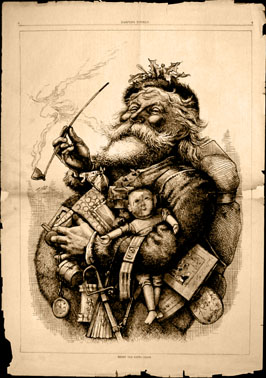 |
"Merry
Old Santa Claus," Harper's Weekly, January 1, 1881, p.8-9. Wood engraving. Medium 184kb Large 664kb Source: http://cartoons.osu.edu/nast/ 12/06/05 |
|
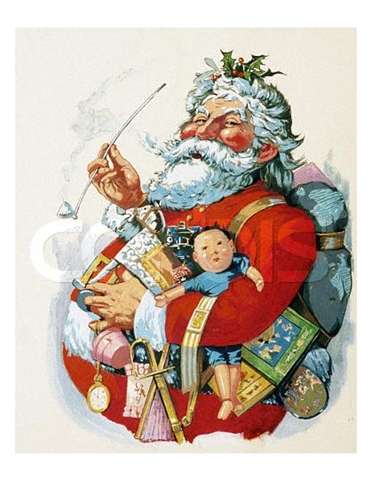 |
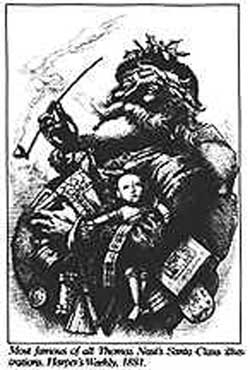 |
|
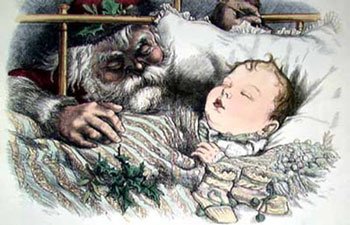 |
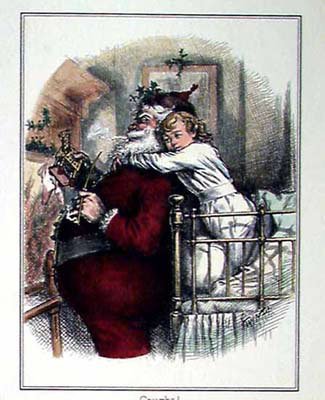 |
|
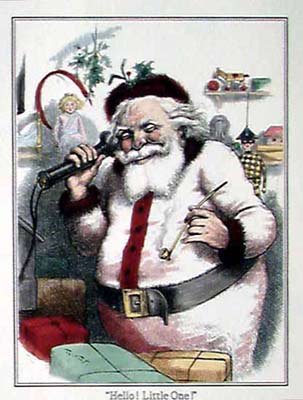 |
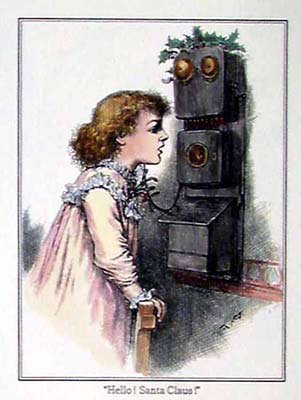 |
|
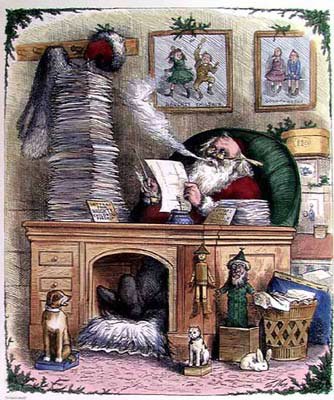 |
||
1866.......... BACK
TO TOP
Nast's 1866 montage entitled "Santa Claus and His Works" established
Santa as a maker of toys.
1869
An 1869 book of the same name collected new Nast drawings with a poem
by George P. Webster that identified the North Pole as Santa's home.
1881
Although Nast never settled on one size for his Santa figures
(they ranged from elf-like to man-sized), his 1881 "Merry Old Santa
Claus" drawing is quite close to the modern-day image. Nast’s
images of Santa Claus were so popular that they were collected and reprinted
in a book published in 1890.
In North American poetry and illustrations, Santa Claus, in his white
beard, red jacket and pompom-topped cap, would sally forth on the night
before Christmas in his sleigh, pulled by eight reindeer, and climb down
chimneys to leave his gifts in stockings children set out on the fireplace's
mantelpiece.
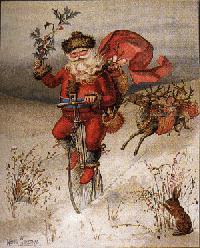 |
Santa Claus on one of those new fangled bi-cycles. |
|
Early 1889.......... BACK TO TOP
Th
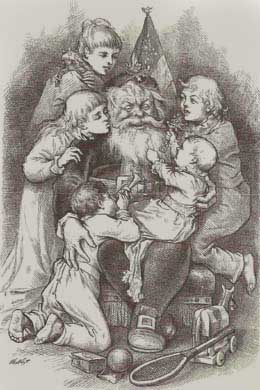 |
Over the last few decades of his life Nast found himself in debt due to bad investments. In 1889, however, old friends of his from Harper's suggested he gather his popular Christmas drawings into a single book which was published under the Harper banner as Christmas Drawings for the Human Race. More info |
|
Early
1900's.......... BACK
TO TOP
The Santa Claus figure, although not yet standardized, was ubiquitous
by the late 19th century. Santa was portrayed as both large and small;
he was usually round but sometimes of normal or slight build; and he
dressed in furs (like Belsnickle) or cloth suits of red, blue, green,
or purple. A Boston printer named Louis Prang introduced the English
custom of Christmas cards to America, and in 1885 he issued a card featuring
a red-suited Santa. The chubby Santa with a red suit (like an "overweight
superhero") began to replace the fur-dressed Belsnickle image and
the multicolored Santas.
1902.......... BACK
TO TOP
Despite the success of Christmas Drawings, Nast was still in
debt at the turn of the century. In 1901 Theodore Roosevelt was elected
as President and, wanting to do something for Nast, appointed him Consul
General in Ecuador. It was there in 1902 he died from yellow fever, though
after having paid off the debt that so bothered him in the final years
of his life. More
info
1917
When the communists took over in Russia and outlawed Christianity, the
Russians began to call Santa Claus Grandfather Frost, who wore blue instead
of the traditional red.
1925
In 1925, since grazing reindeer would not be possible at the North Pole,
newspapers revealed that Santa Claus in fact lived in Finnish Lapland.
1927
"Uncle Markus", Markus Rautio, who compared the popular "Children's
hour" on Finnish public radio, revealed the great secret for the
first time in 1927: Santa Claus lives on Lapland's Korvatunturi - "Ear
Fell"
The fell, which is situated directly on Finland's eastern frontier, somewhat
resembles a hare's ears - which are in fact Santa Claus's ears : ) with
which he listens to hear if the world's children are being nice. Santa
has the assistance of a busy group of elves, who have quite their own
history in Scandinanvian legend.
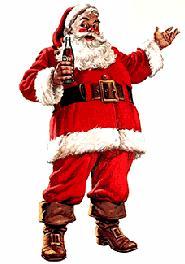 |
Mordern Santa Claus - alias - Santa Cola |
|
1931.......... BACK
TO TOP
The burgeoning Coca-Cola company was still looking for ways to increase
sales of their product during winter, then a slow time of year for the
soft drink market.
In 1931, the Coca-Cola Company decided that they wanted to increase their
sales to children. The law at the time did not allow advertisements showing
children drinking Coca-Cola, so how about showing a friendlier Santa
Claus, relaxing with a Coke served to him by children? The talented commercial
illustrator Haddon Sundblom was assigned to come up with a new, more
commercial Santa. Instead of Moore's elf or Nast's grumpy gnome, Sundblom
came up with a larger than life, jolly fellow in the well-known, bright
red suit with white fur trim (the Coca-Cola colors).
From 1931 to 1964, Haddon Sundblom created a new Santa each Christmas
for Coca-Cola advertisements that appeared world-wide on the back covers
of Post and National Geographic magazines. Coke's annual advertisements — featuring
Sundblom-drawn Santas holding bottles of Coca-Cola, drinking Coca-Cola,
receiving Coca-Cola as gifts, and especially enjoying Coca-Cola — became
a perennial Christmastime feature which helped spur Coca-Cola sales throughout
the winter (and produced the bonus effect of appealing quite strongly
to children, an important segment of the soft drink market).
The success of this advertising campaign has helped fuel the legend that
Coca-Cola actually invented the image of the modern Santa Claus, decking
him out in a red-and-white suit to promote the company colors — or
that at the very least, Coca-Cola chose to promote the red-and-white
version of Santa Claus over a variety of competing Santa figures in order
to establish it as the accepted image of Santa Claus.
This legend is not true. Although some versions of the Santa Claus figure
still had him attired in various colors of outfits past the beginning
of the 20th century, the jolly, ruddy, sack-carrying Santa with a red
suit and flowing white whiskers had become the standard image of Santa
Claus by the 1920s, several years before Sundlom drew his first Santa
illustration for Coca-Cola. As The New York Times reported on 27 November
1927: A standardized Santa Claus appears to New York children. Height,
weight, stature are almost exactly standardized, as are the red garments,
the hood and the white whiskers. The pack full of toys, ruddy cheeks
and nose, bushy eyebrows and a jolly, paunchy effect are also inevitable
parts of the requisite make-up.
All this isn't to say that Coca-Cola didn't have anything to do with
cementing that image of Santa Claus in the public consciousness. The
Santa image may have been standardized before Coca-Cola adopted it for
their advertisements, but Coca-Cola had a great deal to do with establishing
Santa Claus as a ubiquitous Christmas figure in America at a time when
the holiday was still making the transition from a religious observance
to a largely secular and highly commercial celebration. In an era before
color television (or commercial television of any kind), color films,
and the widespread use of color in newspapers, it was Coca-Cola's magazine
advertisements, billboards, and point-of-sale store displays that exposed
nearly everyone in America to the modern Santa Claus image. Coca-Cola
certainly helped make Santa Claus one of the most popular men in America,
but they didn't invent him.
Together, Irving, Moore, Nast and Sundblom are largely responsible for
the way we in America envision Santa Claus.
1939.......... BACK
TO TOP
In modern versions of the Santa Claus legend, only his toy-shop workers
are elves. Rudolph, the ninth reindeer, with a red and shiny nose, was
invented in 1939 by an advertising writer for the Montgomery Ward Company.
1950
Over the centuries, customs from different parts of the Northern Hemisphere
thus came together and
created the whole world's Santa Claus - the ageless, timeless, deathless
white-bearded man who
gives out gifts on Christmas.
1969
Because Saint Nicholas life is so unreliably documented, Pope Paul VI
ordered the feast of Saint Nicholas dropped from the official Roman Catholic
calendar in 1969.
Present
Day North Pole, Santa's Workshop : ) .......... BACK
TO TOP
Since the North Pole was an agreeable neutral territory but, realistically,
unihabitable, the clever people from Finland's Lapland have seemed to
lay claim to Santa's North Pole. Seems somewhat natural as that is where
lots of reindeer come
from (200,000).
See this link describes the thinking:
http://groups.msn.com/965172qg02rbm4ek3a6e7udur5/
Following sites will get you in the Christmas spirit and are
beautifully done.
Click on British flags for English language:
Santa Claus' website: http://www.santaclaus.fi/?deptid=8044
Santa Clause Office: http://www.santaclauslive.com/main.php?kieli=eng
Korvatunturi is
in Finnish Lapland where Santa lives. Santa wanted to make sure his hiding
place was not invaded with visitors and hit upon a brilliant idea that
would allow all his friends and anyone who loved Christmas to come and
meet him.
Ok and here's the story:
Since the 1950s, Santa has happily sojourned near the Arctic Circle at
Napapiiri, near Rovaniemi,
at times other than Christmas, to meet children and the young at heart.
By 1985 his visits to Napapiiri had become so regular that he established
his own Santa Claus Office there. He comes there every day of the year
to hear what children want for Christmas and to talk with children who
have arrived from around the world. Santa Claus Village is also the location
of Santa's main Post Office, which receives children's letters from the
four corners of the world. By 1985 his visits to Napapiiri had become
so regular that he established his own Santa Claus Office there. He comes
there every day of the year to hear what children want for Christmas
and to talk with children who have arrived from around the world. Santa
Claus Village is also the location of Santa's main Post Office, which
receives children's letters from the four corners of the world.
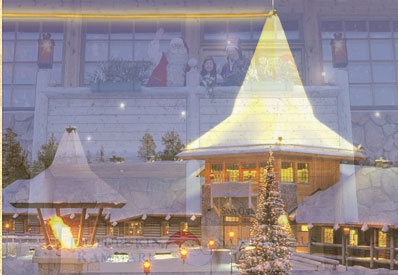
Oh, and Santa does have an address: .......... BACK
TO TOP
Snail mail:
Santa still prefers ordinary snail mail to anything else. And he certainly
gets plenty: more than 700,000 letters a year!
You can write to him at:
Santa Claus
Arctic Circle
96930 Rovaniemi
Finland
PS
Although most adults view Santa as the embodiment of a spirit of giving,
some argue that the modern image of Santa Claus conflicts with the true
meaning of Christmas and promotes greed and commercialism. To reconcile
the legend of Santa Claus with the religious significance of Christmas,
some Christians emphasize that the modern figure is derived from legends
about a saint who symbolized love, caring, and generosity.
Sources:.......... BACK
TO TOP
"American Origins" from ENCARTA 95.
• http://www.art.com
• http://cartoons.osu.edu/nast/
• www.stnicholascenter.org
Flynn, Tom. The Trouble with Christmas.
Buffalo, NY: Prometheus Books, 1993. ISBN 0-87975-848-1 (pp. 112-114).
1. Twitchell, James B. Twenty Ads That Shook the World.
New York: Crown Publishers, 2000. ISBN 0-609-60563-1 (pp. 102-107).
Dream of Santa: Haddon Sundblom's Vision.
Alexandria, VA: Staple & Charles Ltd., 1992. ISBN 0-9634907-0-2 (pp.
7-16).
The Time-Life Book of Christmas.
New York: Prentice Hall, 1987. ISBN 0-13-133679-7.
http://www.unmuseum.org/santa.htm Found
this great historical source! 2005-12-25
CLICK FOR NEXT: Coca-Claus.
Did a soda-pop company invent Santa? Santa Claus02
CLICK FOR MAIN XMAS PAGE
|
|
Tuesday, December 19, 2006 3:14 PM